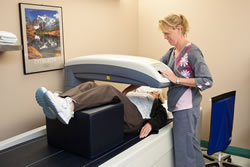Bone Mineral Density
 A bone mineral density (BMD) test measures how much calcium and other types of minerals are present in a section of your bone. Your health care provider uses this test, along with other risk factors, to predict your risk of bone fractures in the future and detect osteoporosis. Bone fracture risk is highest in people with osteoporosis.
A bone mineral density (BMD) test measures how much calcium and other types of minerals are present in a section of your bone. Your health care provider uses this test, along with other risk factors, to predict your risk of bone fractures in the future and detect osteoporosis. Bone fracture risk is highest in people with osteoporosis.
Alternative Names
BMD test; Bone density test; Bone densitometry; DEXA scan; DXA; Dual-energy x-ray absorptiometry; p-DEXA
How the Test is Performed
Several different kinds of machines can do BMD testing. The most common and most accurate method is called a dual-energy x-ray absorptiometry (DEXA) scan. It uses low-dose x-rays (about 1/10th the radiation dose of a chest x-ray).
There are two different types of DEXA scans:
- Central DEXA. While you are lying on a cushioned table, a scanner passes over your lower spine and hip. In most cases you won't need to undress.
- Peripheral DEXA (p-DEXA). These smaller machines measure the bone density in your wrist, fingers, leg, or heel.
At RVH we perform a central DEXA scan that measures bone density in your lower spine or hip is the best test to predict your risk of fractures.
How to Prepare for the Test
Wear clothing that does not have any metal (e.g., no belts, zippers). Inform your health care provider if you may be pregnant.
How the Test Will Feel
The scan is painless, although you will need to remain still during the test.
Why the Test is Performed
Bone mineral density (BMD) tests are used to detect osteoporosis, the thinning of bone tissue and loss of bone density over time.
BMD testing or screening should also be done in the following people, who are thought to be at an increased risk for osteoporosis:
- Women over age 65 and men over age 70
- Women under age 65 and men ages 50 - 70 who have risk factors such as:
- Bone fracture caused by normal activities, such as a fall from standing height or less ("fragility fracture")
- Chronic rheumatoid arthritis, chronic kidney disease, eating disorders
- Early menopause (either from natural causes or surgery)
- History of hormone treatment for prostate cancer or breast cancer
- Significant loss of height
- Smoking
- Strong family history of osteoporosis
- Taking corticosteroid medications (prednisone, methylprednisolone) every day for more than 3 months
- Three or more drinks of alcohol per day on most days
If you are being treated for osteoporosis, BMD testing can help your health care provider monitor your response to treatment.
Normal Results
The results of your test are usually reported as a "T score" and "Z score."
The T score compares your bone density with that of healthy young women.
The Z score compares your bone density with that of other people of your age, gender, and race.
In either score, a negative number means you have thinner bones than the standard. The more negative the number, the higher your risk of a bone fracture.
A T score is within the normal range if it is -1.0 or above.
What Abnormal Results Mean
Bone mineral density testing does not diagnose fractures. However, along with other risk factors you may have, it helps predict your risk of having a bone fracture in the future. Your doctor will help you understand the results.
- A T score between -1 and -2.5 indicates the beginning of bone loss (osteopenia).
- A T score below -2.5 indicates osteoporosis.
Treatment recommendations depend on your total fracture risk.
Risks
BMD testing involves exposure to a low level of radiation. Most experts feel that the risk is very low compared with the benefits of identifying osteoporosis before you break a bone.
Considerations
Simple bone density scans using portable machines may be available as part of health fairs or screenings. These portable scanners may check the density of your wrist or heel. However, keep in mind that hip and spine scans are more reliable.